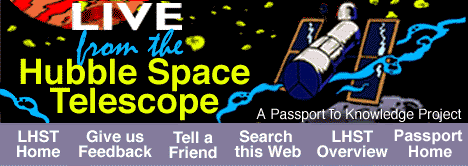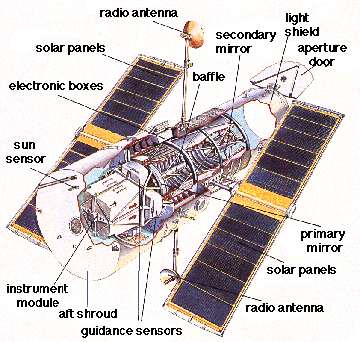
The Hubble Space Telescope

The Science Instruments
The Hubble Space Telescope's current complement of science instruments include
two cameras, two spectrographs, and fine guidance sensors (primarily
used for astrometric observations). Because of HST's location above
the Earth's atmosphere, these science instruments can produce high
resolution images of astronomical objects. Ground-based telescopes
can seldom provide resolution better than 1.0 arc-seconds, except
momentarily under the very best observing conditions. HST's
resolution is about 10 times better, or 0.1 arc-seconds.
Wide Field/Planetary Camera 2
The original Wide Field/Planetary Camera (WF/PC1) was changed
out and displaced by WF/PC2 on the STS-61 shuttle mission in December 1993.
WF/PC2 was a spare instrument developed in 1985 by the Jet Propulsion
Laboratory in Pasadena, California.
WF/PC2 is actually four cameras. The relay mirrors in WF/PC2
are spherically aberrated to correct for the spherically aberrated
primary mirror of the observatory. (HST's primary mirror is 2 microns
too flat at the edge, so the corrective optics within WF/PC2 are too
high by that same amount.)
The ``heart'' of WF/PC2 consists of an L-shaped trio of wide-field
sensors and a smaller, high resolution ("planetary") camera tucked in
the square's remaining corner.
Corrective Optics Space Telescope Axial Replacement
COSTAR is not a science instrument; it is a corrective optics
package that displaced the High Speed Photometer during the first
servicing mission to HST. COSTAR is designed to optically correct
the effects of the primary mirror's aberration on the three remaining
scientific instruments: Faint Object Camera (FOC), Faint Object
Spectrograph (FOS), and the Goddard High Resolution Spectrograph (GHRS).
Faint Object Camera
The Faint Object Camera is built by the European Space Agency.
It is the only instrument to utilize the full spatial resolving power
of HST.
There are two complete detector systems of the FOC. Each uses
an image intensifier tube to produce an image on a phosphor screen that
is 100,000 times brighter than the light received. This phosphor image
is then scanned by a sensitive electron-bombarded silicon (EBS) television
camera. This system is so sensitive that objects brighter than 21st
magnitude must be dimmed by the camera's filter systems to avoid saturating
the detectors. Even with a broad-band filter, the brightest object which
can be accurately measured is 20th magnitude.
The FOC offers three different focal ratios: f/48, f/96, and
f/288 on a standard television picture format. The f/48 image measures
22 X 22 arc-seconds and yields resolution (pixel size) of 0.043 arc-seconds.
The f/96 mode provides an image of 11 X 11 arc-seconds on each side and a
resolution of 0.022 arc-seconds. The f/288 field of view is 3.6 X 3.6 arc-
seconds square, with resolution down to 0.0072 arc-seconds.
Faint Object Spectrograph
A spectrograph spreads out the light gathered by a telescope so
that it can be analyzed to determine such properties of celestial objects
as chemical composition and abundances, temperature, radial velocity,
rotational velocity, and magnetic fields. The Faint Object Spectrograph
(FOS) exmaines fainter objects than the HRS, and can study these objects
across a much wider spectral range -- from the UV (1150 Angstroms) through
the visible red and the near-IR (8000 Angstroms).
The FOS uses two 512-element Digicon sensors (light intensifiers)
to gather light. The "blue" tube is sensitive from 1150 to 5500 Angstroms
(UV to
yellow). The "red" tube is sensitive from 1800 to 8000 Angstroms (longer
UV through red). Light can enter the FOS through any of 11 different
apertures from 0.1 to about 1.0 arc-seconds in diameter. There are also
two occulting devices to block out light from the center of an object while
allowing the light from just outside the center to pass on through. This
could allow analysis of the shells of gas around red giant stars of the
faint galaxies around a quasar.
The FOS has two modes of operation PP low resolution and high
resolution. At low resolution, it can reach 26th magnitude in one hour
with a resolving power of 250. At high resolution, the FOS can reach
only 22nd magnitude in an hour (before S/N becomes a problem), but the
resolving power is increased to 1300.
Goddard High Resolution Spectrograph
The High Resolution Spectrograph also separates incoming light
into its spectral components so that the composition, temperature,
motion, and other chemical and physical properties of the objects can
be analyzed. The HRS contrasts with the FOS in that it concentrates
entirely on UV spectroscopy and trades the extremely faint objects for
the ability to analyze very fine spectral detail. Like the FOS, the
HRS uses two 521-channel Digicon electronic light detectors, but the
detectors of the HRS are deliberately blind to visible light. One tube
is sensitive from 1050 to 1700 Angstroms; while the other is sensitive
from 1150 to 3200 Angstroms.
The HRS also has three resolution modes: low, medium, and high.
"Low resolution" for the HRS is 2000 -- higher than the best resolution
available on the FOS. Examining a feature at 1200 Angstroms, the HRS
can resolve detail of 0.6 Angstroms and can examine objects down to
19th magnitude. At medium resolution of 20,000; that same spectral
feature at 1200 Angstroms can be seen in detail down to 0.06 Angstroms,
but the object must be brighter than 16th magnitude to be studied. High
resolution for the HRS is 100,000; allowing a spectral line at 1200
Angstroms to be resolved down to 0.012 Angstroms. However, "high resolution"
can be applied only to objects of 14th magnitude or brighter. The HRS can
also discriminate between variation in light from ojbects as rapid as 100
milliseconds apart.
Attitude Control
The Hubble Space Telescope uses an elaborate scheme for attitude control to improve the stability of the spacecraft during
observations. Four of six gyros track how fast the HST is moving, the
reaction wheels turn the telescope. Pointing can be
maintained in this mode (coarse track) or the Fine Guidance Sensors (FGSs) can be used to lock onto
guide stars (fine lock) to reduce the spacecraft drift and increase the pointing accuracy.
Solar Power
Power to the two on-board computers and the scientific instruments is provided by two 2.4 x 12.1 m
solar panels. The power generated by the arrays is also used to charge six nickel-hydrogen batteries
which provides power to the spacecraft during the roughly 25 minutes per orbit in which HST is within
the Earth's shadow.
Communications Equipment
Communications with the satellite are maintained with the TDRS satellites. Observations taken during the
time when neither TDRS was visible from the spacecraft are recorded on tape recorder and dumped
during periods of visibility. The spacecraft also supports real-time interactions with the ground system
during times of TDRS visibility, enabling observers to make small offsets in the spacecraft pointing to
perform their observations. HST was the first scientific spacecraft designed to utilize the full capabilities of
TDRSS, communicating over either multiple-access or single-access channels at any of the supported
transmission rates.
The two high-gain antennae provide communications with the ground (via the Tracking and Data Relay Satellite System). Power, control, and communications functions are carried out by the Support Systems Module (SSM), which encircles the primary mirror.
Information for this description of the Hubble Telescope came from the National Space Science Data Center and the Space Telescope Science Institute.






![]()